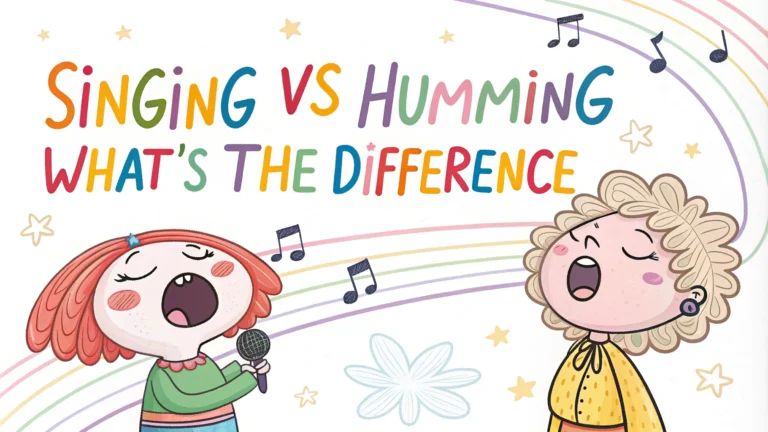The human voice creates **musical expressions** in two distinct ways: singing and humming. While both activities produce melodic sounds, they differ significantly in technique, sound production, and practical applications.
Many performers and vocal enthusiasts often wonder about the unique benefits and proper techniques for both methods. This quick guide breaks down the key differences and helps you understand when to use each approach.
The Science Behind Voice Production
**Vocal cords** work differently during singing versus humming. During singing, the mouth opens fully and air flows freely, while humming involves keeping the lips closed with air resonating through the nasal cavity.
- Singing: Full vocal cord engagement with open mouth
- Humming: Controlled airflow through closed lips
- Sound resonance: Different cavity usage (oral vs nasal)
Benefits and Applications of Humming
**Humming** serves as a gentle warm-up exercise and therapeutic vocal technique. Research shows it can help reduce stress and improve breathing patterns.
- Vocal cord relaxation
- Breath control development
- Stress reduction
- Pitch recognition practice
Key Elements of Singing Technique
**Proper singing** involves coordinating multiple body parts and techniques. Understanding these fundamentals helps develop stronger vocal abilities.
- Breath support
- Pitch control
- Articulation
- Vowel placement
| Aspect | Singing | Humming |
|---|---|---|
| Mouth Position | Open | Closed |
| Volume Range | Wide | Limited |
| Vocal Strain | Higher | Lower |
Practical Applications in Voice Training
Voice training requires a **balanced approach** between singing and humming exercises. Alternating between these techniques helps build vocal strength and versatility.
- Start with humming warm-ups
- Progress to simple singing exercises
- Mix techniques during practice sessions
- Monitor vocal fatigue levels
Common Mistakes to Avoid
Many beginners make **preventable errors** that can affect their vocal development. Understanding these pitfalls helps maintain vocal health and progress.
- Pushing too hard during practice
- Skipping warm-up exercises
- Incorrect breathing techniques
- Poor posture while singing
Daily Practice Routine
A **structured practice schedule** enhances vocal development. Focus on consistent, quality practice rather than lengthy sessions.
| Time | Activity | Duration |
|---|---|---|
| Morning | Gentle humming | 5-10 mins |
| Afternoon | Singing exercises | 15-20 mins |
| Evening | Cool-down humming | 5 mins |
Building Long-term Vocal Health
Maintaining **vocal health** requires ongoing attention and care. Regular practice combined with proper technique builds a foundation for sustainable vocal development.
- Stay hydrated throughout the day
- Practice proper voice rest
- Schedule regular vocal checkups
- Listen to your body’s signals
“The key to vocal longevity lies in consistent, mindful practice rather than intense, sporadic sessions.”
Remember to balance both singing and humming in your practice routine. Track your progress and adjust techniques as needed for optimal vocal development.
FAQs About Singing vs Humming
Q: What is the main difference between singing and humming?
A: Singing involves producing vocalized sounds with an open mouth using lyrics and distinct words, while humming creates musical sounds with closed lips and no words. Humming produces a more contained, buzzing sound through the nasal cavity.
Q: Is humming easier than singing for beginners?
A: Yes, humming is generally easier for beginners because it:
- Requires less vocal control
- Places less strain on vocal cords
- Helps develop proper breath support
- Creates natural resonance in the vocal cavity
Q: Can humming improve your singing voice?
A: Yes, humming is an effective vocal warm-up technique that:
- Develops pitch control
- Strengthens vocal muscles
- Improves breath support
- Enhances vocal resonance
Q: Why does my voice sound better when humming?
A: Your voice often sounds better when humming because the closed-mouth position creates stronger vocal resonance in your nasal and sinus cavities, providing natural amplification and feedback.
Q: Does humming use the same muscles as singing?
A: Yes, humming and singing use the same core vocal muscles, including the:
- Diaphragm
- Laryngeal muscles
- Vocal cords
- Soft palate
Q: What are the health benefits of humming vs singing?
A: Both activities offer health benefits:
| Humming Benefits | Singing Benefits |
|---|---|
| – Increases nitric oxide production – Reduces stress – Helps clear sinuses |
– Improves lung capacity – Boosts immune system – Releases endorphins |
Q: Can someone who hums well automatically sing well?
A: Not necessarily. While humming indicates basic pitch awareness, singing requires additional skills like proper articulation, vowel placement, and word pronunciation.
Q: What burns more calories: singing or humming?
A: Singing burns more calories than humming because it engages more muscles and requires more physical effort. Professional singers can burn 100-300 calories per hour during intense performances.
Q: Is humming good for meditation and relaxation?
A: Yes, humming is particularly effective for meditation because it creates vibrations that can calm the nervous system and produce a natural resonance frequency that promotes relaxation.
Q: What’s the difference in vocal range between singing and humming?
A: Most people have a similar vocal range for both activities, but singing often allows for slightly higher notes due to the open mouth position and better air flow.
Q: Can babies hum before they can sing?
A: Yes, babies typically develop the ability to hum around 6-8 months of age, while singing with recognizable melodies usually develops between 1-2 years old.



















